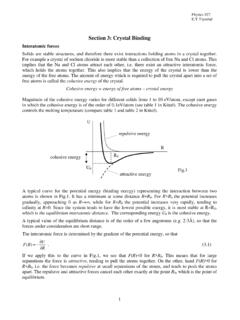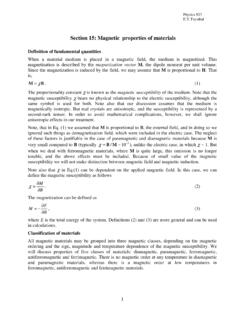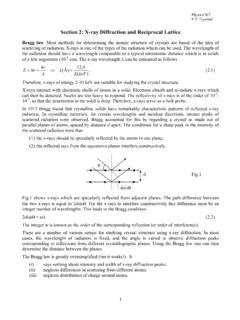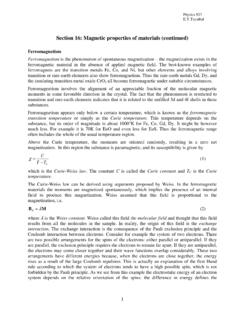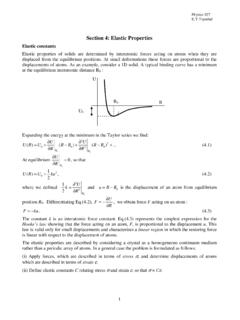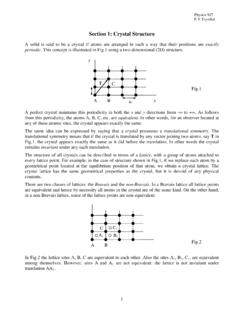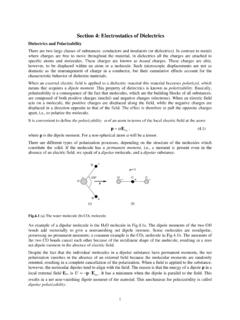Transcription of Section 5: Lattice Vibrations - University of Nebraska ...
1 Physics 927. Section 5: Lattice Vibrations So far we have been discussing equilibrium properties of crystal lattices. When the Lattice is at equilibrium each atom is positioned exactly at its Lattice site. Now suppose that an atom displaced from its equilibrium site by a small amount. Due to force acting on this atom, it will tend to return to its equilibrium position. This results in Lattice Vibrations . Due to interactions between atoms, various atoms move simultaneously, so we have to consider the motion of the entire Lattice . One-dimensional Lattice For simplicity we consider, first, a one-dimensional crystal Lattice and assume that the forces between the atoms in this Lattice are proportional to relative displacements from the equilibrium positions. un 1 un un+1. n 1 n n+1 a This is known as the harmonic approximation, which holds well provided that the displacements are small. One might think about the atoms in the Lattice as interconnected by elastic springs. Therefore, the force exerted on n-the atom in the Lattice is given by Fn = C (un +1 un ) + C (un 1 un ) , ( ).
2 Where C is the interatomic force (elastic) constant. Applying Newton's second law to the motion of the n-th atom we obtain d 2 un M = Fn = C (un +1 un ) + C (un 1 un ) = C (2un un +1 un 1 ) , ( ). dt 2. where M is the mass of the atom. Note that we neglected here by the interaction of the n-th atom with all but its nearest neighbors. A similar equation should be written for each atom in the Lattice , resulting in N coupled differential equations, which should be solved simultaneously (N is the total number of atoms in the Lattice ). In addition the boundary conditions applied to the end atom in the Lattice should be taken into account. Now let us attempt a solution of the form un = Aei ( qxn t ) ( ). where xn is the equilibrium position of the n-th atom so that xn=na. This equation represents a traveling wave, in which all the atoms oscillate with the same frequency and the same amplitude A and have wavevector q. Note that a solution of the form ( ) is only possible because of the transnational symmetry of the Lattice .
3 Now substituting Eq.( ) into Eq.( ) and canceling the common quantities (the amplitude and the time-dependent factor) we obtain M ( 2 )e iqna = C 2 e iqna e iq ( n +1) a e iq ( n 1) a ( ). This equation can be further simplified by canceling the common factor eiqna , which leads to 1. Physics 927. M 2 = C ( 2 eiqa e iqa ) = 2C (1 cos qa ) = 4C sin 2. qa . ( ). 2. We find therefore the dispersion relation for the frequency 4C qa = sin , ( ). M 2. which is the relationship between the frequency of Vibrations and the wavevector q. This dispersion relation have a number of important properties. (i) Reducing to the first Brillouin zone. The frequency ( ) and the displacement of the atoms ( ) do not change when we change q by q+2 /a. This means that these solutions are physically identical. This allows us to set the range of independent values of q within the first Brillouin zone, . q . ( ). a a Within this range of q the versus q is shown in 1/2. /(4c/M). - /a 0 /a q The maximum frequency is 4C / M.
4 The frequency is symmetric with respect to the sign change in q, (q)= (-q). This is not surprising because a mode with positive q corresponds to the wave traveling in the Lattice from the left to the right and a mode with a negative q corresponds to the wave traveling from the right tot the left. Since these two directions are equivalent in the Lattice the frequency does not change with the sign change in q. At the boundaries of the Brillouin zone q= /a the solution represents a standing wave un = A( 1) n e i t : atoms oscillate in the opposite phases depending on whether n is even or odd. The wave moves neither right nor left. (ii) Phase and group velocity. The phase velocity is defined by . vp = ( ). q and the group velocity by d . vg = . ( ). dq 2. Physics 927. The physical distinction between the two velocities is that vp is the velocity of the propagation of the plane wave, whereas the vg is the velocity of the propagation of the wave packet. The latter is the velocity for the propagation of energy in the medium.
5 For the particular dispersion relation ( ) the group velocity is given by Ca 2 qa vg = cos . ( ). M 2. As is seen from Eq.( ) the group velocity is zero at the edge of the zone where q= /a. Here the wave is standing and therefore the transmission velocity for the energy is zero. (iii) Long wavelength limit. The long wavelength limit implies that >>a. In this limit qa<<1. We can then expand the sine in Eq.( ) and obtain for the positive frequencies: C. = qa . ( ). M. We see that the frequency of vibration is proportional to the wavevector. This is equivalent to the statement that velocity is independent of frequency. In this case C. vp = = a. ( ). q M. This is the velocity of sound for the one dimensional Lattice which is consistent with the expression we obtained earlier for elastic waves. Diatomic 1D Lattice Now we consider a one-dimensional Lattice with two non-equivalent atoms in a unit cell. It appears that the diatomic Lattice exhibit important features different from the monoatomic case.
6 Shows a diatomic Lattice with the unit cell composed of two atoms of masses M1 and M2 with the distance between two neighboring atoms a. M1 M2. n 1 n n+1 a We can treat the motion of this Lattice in a similar fashion as for monoatomic Lattice . However, in this case because we have two different kinds of atoms, we should write two equations of motion: d 2 un M1 = C (2un un +1 un 1 ). dt 2 . ( ). d 2un +1. M2 = C (2un +1 un + 2 un ). dt 2. In analogy with the monoatomic Lattice we are looking for the solution in the form of traveling mode for the two atoms: 3. Physics 927. un A1eiqna = iq ( n +1) a e i t , ( ). un +1 A2 e which is written in the obvious matrix form. Substituting this solution to Eq.( ) we obtain 2C M 1 2 2C cos qa A1. =0. ( ). 2C cos qa 2C M 2 2 A2. This is a system of linear homogeneous equations for the unknowns A1 and A2. A nontrivial solution exists only if the determinant of the matrix is zero. This leads to the secular equation (2C M 1 2 )(2C M 2 2 ) 4C 2 cos 2 qa = 0.
7 ( ). This is a quadratic equation, which can be readily solved: 2. 1 1 1 1 4sin 2 qa =C. 2. + C + . ( ). M1 M 2 M1 M 2 M 1M 2. Depending on sign in this formula there are two different solutions corresponding to two different dispersion curves, as is shown in : Optical . Acoustic - /2a 0 /2a q The lower curve is called the acoustic branch, while the upper curve is called the optical branch. The optical branch begins at q=0 and =0. Then with increasing q the frequency increases in a linear fashion. This is why this branch is called acoustic: it corresponds to elastic waves or sound. Eventually this curve saturates at the edge of the Brillouin zone. On the other hand, the optical branch has a non- zero frequency at zero q 1 1. 0 = 2C + . ( ). M1 M 2. and it does not change much with q. The distinction between the acoustic and optical branches of Lattice Vibrations can be seen most clearly by comparing them at q=0 (infinite wavelength). As follows from Eq.( ), for the acoustic branch =0 and A1=A2.
8 So in this limit the two atoms in the cell have the same amplitude and the phase. Therefore, the molecule oscillates as a rigid body, as shown in for the acoustic mode. 4. Physics 927. Acoustic Optical On the other hand, for the optical Vibrations , substituting Eq.( ) to Eq.( ), we obtain for q=0: M 1 A1 + M 2 A2 = 0 . ( ). It implies that the optical oscillation takes place in such a way that the center of mass of a molecule remains fixed. The two atoms move in out of phase as shown in The frequency of these Vibrations lies in infrared region which is the reason for referring to this branch as optical. Three dimensional Lattice These considerations can be extended to the three-dimensional Lattice . To avoid mathematical details we shall present only a qualitative discussion. Consider, first, the monatomic Bravais Lattice , in which each unit cell has a single atom. The equation of motion of each atom can be written in a manner similar to that of Eq.( ). The solution of this equation in three dimensions can be represented in terms of normal modes u = Aei ( qr t ) ( ).
9 Where the wave vector q specifies both the wavelength and direction of propagation. The vector A. determines the amplitude as well as the direction of vibration of the atoms. Thus this vector specifies the polarization of the wave, , whether the wave is longitudinal (A parallel to q) or transverse (A. perpendicular to q). When we substitute Eq.( ) into the equation of motion, we obtain three simultaneous equations involving Ax, Ay. and Az, the components of A. These equations are coupled together and are equivalent to a 3 x 3 matrix equation. The roots of this equation lead to three different dispersion relations, or three dispersion curves, as shown in All three branches pass through the origin, which means all the branches are acoustic. This is of course to be expected, since we are dealing with a monatomic Bravais Lattice . 5. Physics 927. The three branches in differ in their polarization. When q lies along a direction of high symmetry - for example, the[100] or [110] directions these waves may be classified as either pure longitudinal or pure transverse waves.
10 In that case, two of the branches are transverse and one is longitudinal. One usually refers to these as the TA - transverse acoustic and LA longitudinal acoustic branches, respectively. However, along non-symmetry directions the waves may not be pure longitudinal or pure transverse, but have a mixed character. Figure 7 shows the dispersion curves for Al in the [100] and [110] directions. Note that in certain high-symmetry directions, such as the [100] in Al, the two transverse branches coincide. The branches are then said to be degenerate. We turn our attention now to the non-Bravais three-dimensional Lattice . Here the unit cell contains two or more atoms. If there are s atoms per cell, then on the basis of our previous experience we conclude that there are 3s dispersion curves. Of these, three branches are acoustic, and the remaining (3s 3) are optical. The mathematical justification for this assertion is as follows: We write the equation of motion for each atom in the cell, which results in s equations.
